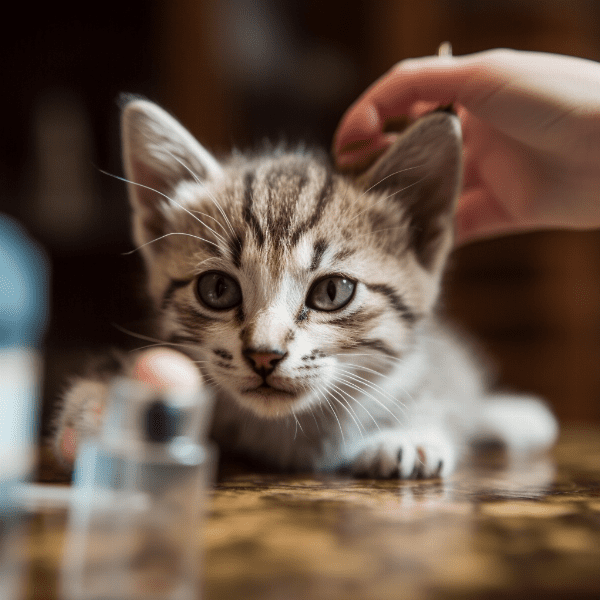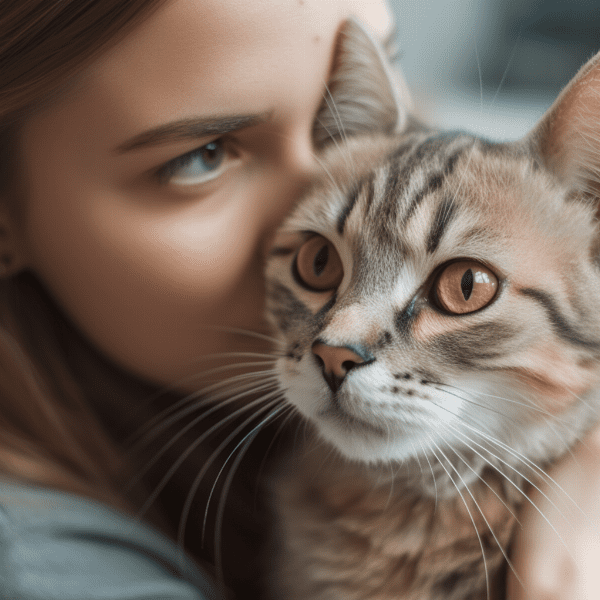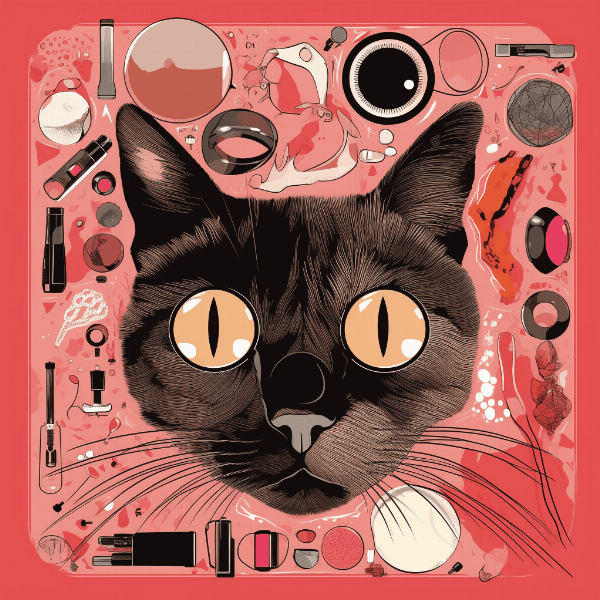Table of Contents
- Understanding Feline Conjunctivitis
- Symptoms of Conjunctivitis in Cats
- Causes of Feline Conjunctivitis
- Diagnosis of Conjunctivitis in Cats
- Tips for Preventing Conjunctivitis in Cats
- Home Remedies for Treating Feline Conjunctivitis
- Medications for Feline Conjunctivitis
- Surgical Options for Severe Cases
- Follow-up Care for Cats with Conjunctivitis
- When to See a Veterinarian for Feline Conjunctivitis
Understanding Feline Conjunctivitis
Feline conjunctivitis is a common eye condition that affects cats of all ages, breeds, and sexes. It is a painful inflammation of the conjunctiva, the thin and transparent membrane that covers the inner surface of the eyelids and the white part of the eye.
Anatomy of a Cat’s Eye
To understand conjunctivitis in cats, it’s important to understand the basic anatomy of a cat’s eye. A cat’s eye is composed of several parts, including the cornea, the lens, the retina, and the optic nerve. The cornea is the clear, dome-shaped surface that covers the front of the eye, while the lens is a transparent structure that helps focus light onto the retina. The retina is a layer of cells at the back of the eye that converts light into nerve impulses, which are then transmitted to the brain via the optic nerve.
What Causes Feline Conjunctivitis?
Feline conjunctivitis can be caused by a variety of factors, including bacterial, viral, and fungal infections, allergies, foreign objects in the eye, and trauma. Bacterial conjunctivitis is the most common type of conjunctivitis in cats and is typically caused by the bacteria Chlamydia psittaci and Mycoplasma felis. Viral conjunctivitis is caused by several different viruses, including feline herpesvirus-1 (FHV-1), which is the most common cause of viral conjunctivitis in cats. Fungal conjunctivitis is caused by fungi such as Aspergillus and Candida, while allergies and foreign objects in the eye can also cause conjunctivitis.
Symptoms of Feline Conjunctivitis
The most common symptoms of conjunctivitis in cats include redness, swelling, discharge, and squinting of the affected eye. Other symptoms may include tearing, sensitivity to light, and rubbing or pawing at the eye. In severe cases, conjunctivitis can cause corneal ulcers, which can lead to vision loss if left untreated.
Diagnosis of Feline Conjunctivitis
If you suspect that your cat may have conjunctivitis, it is important to take them to a veterinarian for a proper diagnosis. The veterinarian will perform a physical examination of the eye and may also perform diagnostic tests, such as a culture and sensitivity test, to determine the cause of the conjunctivitis. Once a diagnosis has been made, the veterinarian will be able to recommend the best course of treatment for your cat’s specific condition.
In the next section, we will discuss the symptoms of conjunctivitis in cats in more detail.
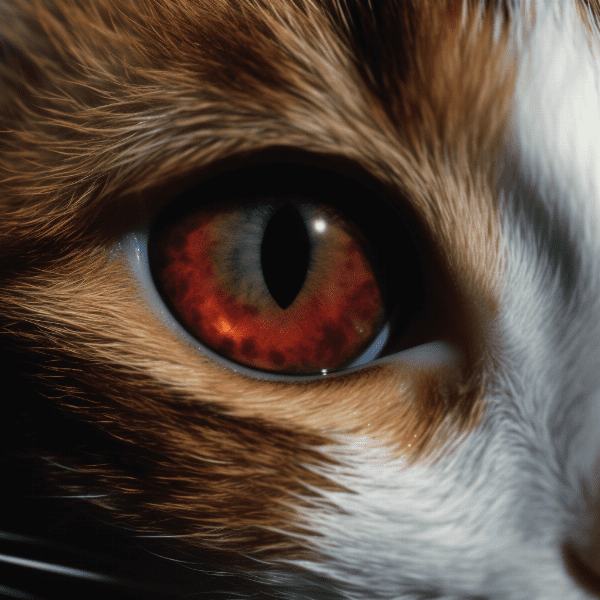
Symptoms of Conjunctivitis in Cats
As mentioned in the previous section, the symptoms of conjunctivitis in cats can vary depending on the underlying cause and the severity of the condition. Here are some of the most common symptoms of feline conjunctivitis:
Discharge
Cats with conjunctivitis may also have discharge from the affected eye. The discharge can vary in color and consistency depending on the cause of the conjunctivitis. In bacterial conjunctivitis, the discharge is often thick and yellowish-green, while in viral conjunctivitis, the discharge is usually watery.
Squinting and Blinking
Cats with conjunctivitis may squint or blink frequently, especially if the condition is causing discomfort or pain. Squinting and blinking can also help reduce the amount of light entering the eye, which can be painful in cases of severe conjunctivitis.
Tearing
Excessive tearing or watery eyes can also be a symptom of conjunctivitis in cats. This is often due to irritation or inflammation of the conjunctiva.
Rubbing or Pawing at the Eye
Cats with conjunctivitis may also rub or paw at the affected eye, especially if the condition is causing itching or discomfort. However, this can worsen the condition and should be discouraged.
It is important to note that while these symptoms are common in cats with conjunctivitis, they can also be indicative of other eye conditions. Therefore, if your cat is exhibiting any of these symptoms, it is important to seek veterinary care for a proper diagnosis and treatment.
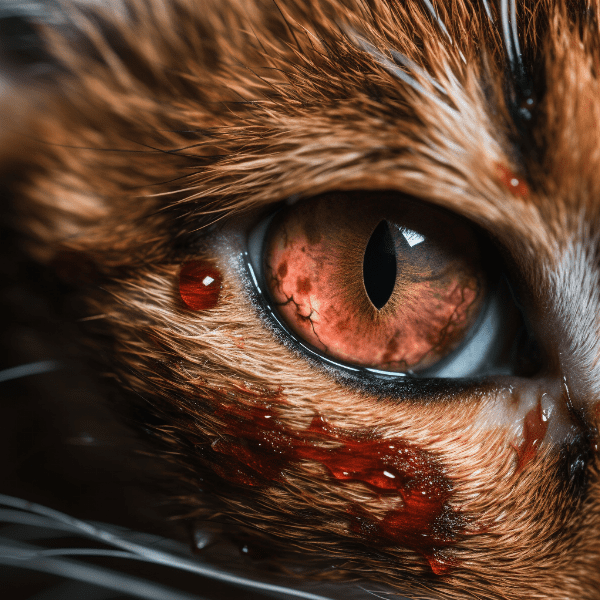
Causes of Feline Conjunctivitis
As mentioned earlier, there are several different factors that can cause feline conjunctivitis. Here are some of the most common causes:
Bacterial Infections
Bacterial infections are the most common cause of conjunctivitis in cats. The bacteria Chlamydia psittaci and Mycoplasma felis are two of the most common bacteria responsible for feline conjunctivitis. These bacteria can be spread through direct contact with an infected cat or through contaminated surfaces.
Viral Infections
Several different viruses can cause conjunctivitis in cats. Feline herpesvirus-1 (FHV-1) is one of the most common viruses responsible for conjunctivitis in cats. FHV-1 is highly contagious and can be spread through direct contact with an infected cat or through contaminated surfaces.
Fungal Infections
Fungal infections can also cause conjunctivitis in cats, although they are less common than bacterial and viral infections. Aspergillus and Candida are two of the most common fungi responsible for feline conjunctivitis.
Allergies
Allergies can cause conjunctivitis in cats, just as they can in humans. Common allergens that can trigger conjunctivitis in cats include pollen, dust, and certain foods. Allergic conjunctivitis is usually accompanied by other symptoms, such as sneezing and itching.
Foreign Objects in the Eye
Foreign objects, such as dust or debris, can irritate the conjunctiva and cause conjunctivitis. Cats who spend time outdoors or in dusty environments are more likely to develop conjunctivitis due to foreign objects.
Trauma
Trauma to the eye can also cause conjunctivitis in cats. This can include injuries such as scratches or cuts to the eye, or blunt force trauma to the head.
It’s important to note that some cats may be more prone to developing conjunctivitis than others, particularly those with weakened immune systems or underlying health conditions. Additionally, cats who live in crowded or stressful environments may be at higher risk of developing conjunctivitis due to increased exposure to infectious agents.
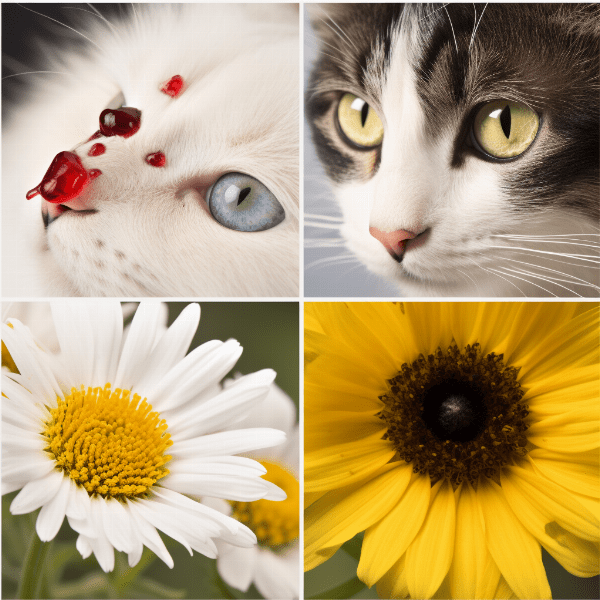
Diagnosis of Conjunctivitis in Cats
If you suspect that your cat may have conjunctivitis, it’s important to take them to a veterinarian for a proper diagnosis. Here are some of the diagnostic methods that veterinarians may use to diagnose conjunctivitis in cats:
Physical Examination
During a physical examination, the veterinarian will examine the affected eye and look for signs of redness, swelling, discharge, and other symptoms of conjunctivitis. The veterinarian may also check the other eye to make sure it is not affected.
Diagnostic Tests
In addition to a physical examination, the veterinarian may perform diagnostic tests to determine the underlying cause of the conjunctivitis. These tests may include a culture and sensitivity test to identify the specific bacteria or fungus responsible for the infection. Blood tests may also be performed to check for underlying health conditions that may be contributing to the conjunctivitis.
Fluorescein Staining
Fluorescein staining is a diagnostic test that involves placing a small amount of fluorescent dye into the eye. The dye will stick to any abrasions or ulcers on the surface of the eye, which can help the veterinarian diagnose corneal ulcers or other conditions that may be causing or contributing to the conjunctivitis.
Schirmer Tear Test
The Schirmer tear test is a diagnostic test that measures the amount of tear production in the eye. This test can help the veterinarian determine if the conjunctivitis is causing a decrease in tear production, which can lead to dry eye and other complications.
Once a diagnosis has been made, the veterinarian will be able to recommend the best course of treatment for your cat’s specific condition. In the next section, we will discuss some tips for preventing conjunctivitis in cats.
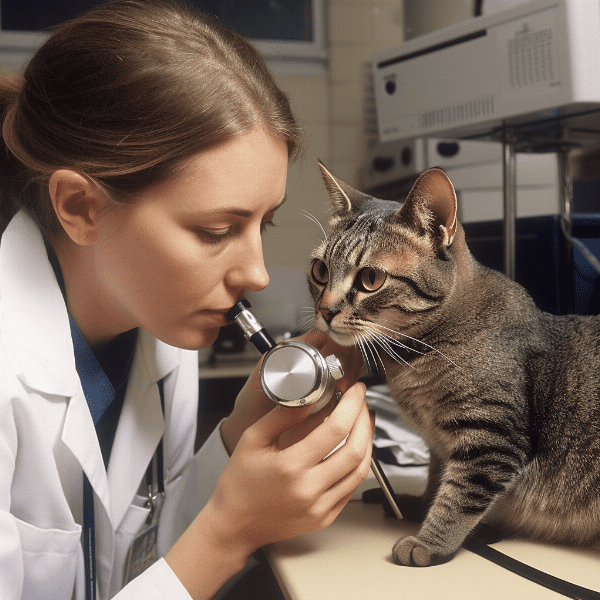
Tips for Preventing Conjunctivitis in Cats
While some cases of conjunctivitis in cats are unavoidable, there are several steps you can take to reduce your cat’s risk of developing this condition. Here are some tips for preventing conjunctivitis in cats:
Vaccination
One of the most effective ways to prevent viral conjunctivitis in cats is through vaccination. The feline herpesvirus-1 (FHV-1) vaccine is highly effective at preventing this virus, which is a common cause of conjunctivitis in cats.
Regular Eye Examinations
Regular eye examinations by a veterinarian can help detect early signs of conjunctivitis and other eye conditions. Early detection and treatment can prevent the condition from becoming more severe and reduce the risk of complications.
Good Hygiene
Good hygiene practices can also help prevent conjunctivitis in cats. This includes keeping the litter box clean and washing your hands before and after handling your cat. It’s also important to keep your cat’s living area clean and free of any potential sources of infection.
Avoid Irritants
Avoiding irritants such as smoke and chemicals can help reduce your cat’s risk of developing conjunctivitis. If you smoke, try to do so outside and away from your cat. Additionally, avoid using harsh chemicals in your home that could irritate your cat’s eyes.
Proper Nutrition
Proper nutrition is important for maintaining a healthy immune system, which can help prevent infections that can lead to conjunctivitis. Make sure your cat is getting a balanced diet that meets their nutritional needs.
By following these tips, you can help reduce your cat’s risk of developing conjunctivitis and other eye conditions. However, if you notice any signs of conjunctivitis in your cat, it’s important to seek veterinary care as soon as possible to prevent the condition from becoming more severe.

Home Remedies for Treating Feline Conjunctivitis
While it’s important to seek veterinary care for conjunctivitis in cats, there are some home remedies that can help alleviate your cat’s symptoms and promote healing. Here are some home remedies for treating feline conjunctivitis:
Warm Compresses
Applying a warm compress to the affected eye can help reduce inflammation and soothe your cat’s eye. To make a warm compress, soak a clean cloth in warm water and wring it out. Hold the compress against your cat’s eye for a few minutes, making sure the compress is warm but not too hot.
Saline Solution
A saline solution can help flush out any debris or discharge from your cat’s eye and promote healing. To make a saline solution, mix 1/4 teaspoon of salt in one cup of boiled water and let it cool. Use a clean dropper to apply a few drops of the saline solution to your cat’s eye several times a day.
Aloe Vera
Aloe vera has soothing and anti-inflammatory properties that can help reduce redness and swelling in your cat’s eye. Use a clean dropper to apply a few drops of aloe vera gel to your cat’s eye several times a day.
It’s important to note that while these home remedies can be helpful in alleviating your cat’s symptoms, they are not a substitute for veterinary care. If your cat’s symptoms persist or worsen, or if you notice any other signs of illness, it’s important to seek veterinary care as soon as possible.
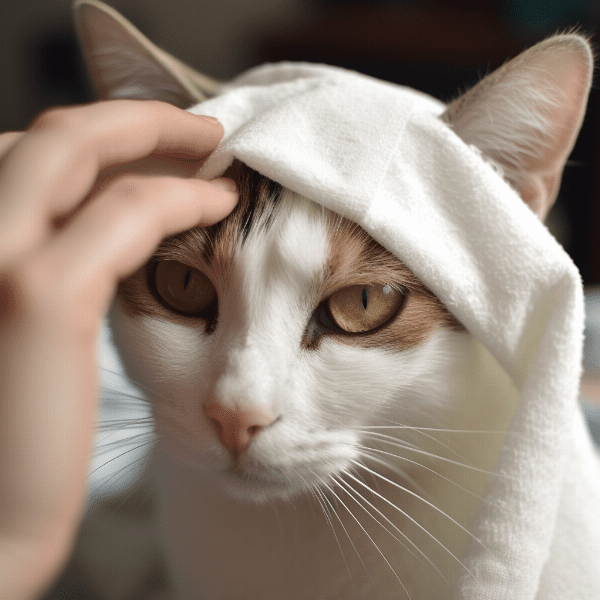
Medications for Feline Conjunctivitis
If your cat has conjunctivitis, your veterinarian may prescribe medications to help alleviate their symptoms and promote healing. Here are some of the most common medications used to treat feline conjunctivitis:
Antifungals
Antifungal medications may be prescribed to treat fungal conjunctivitis in cats. These medications work by killing or inhibiting the growth of the fungi. Common antifungal medications used to treat feline conjunctivitis include fluconazole and itraconazole.
Steroids
Steroids may be prescribed to reduce inflammation and swelling in the eye. However, steroids should only be used under the supervision of a veterinarian, as they can have side effects if not used properly.
Artificial Tears
Artificial tears may be prescribed to help lubricate the eye and alleviate dryness and discomfort associated with conjunctivitis. These drops are usually applied several times a day as needed.
It’s important to follow your veterinarian’s instructions carefully when administering medications to your cat, including the dosage and frequency of administration. In addition to medications, your veterinarian may also recommend other treatments, such as eye drops or ointments, to help alleviate your cat’s symptoms and promote healing.
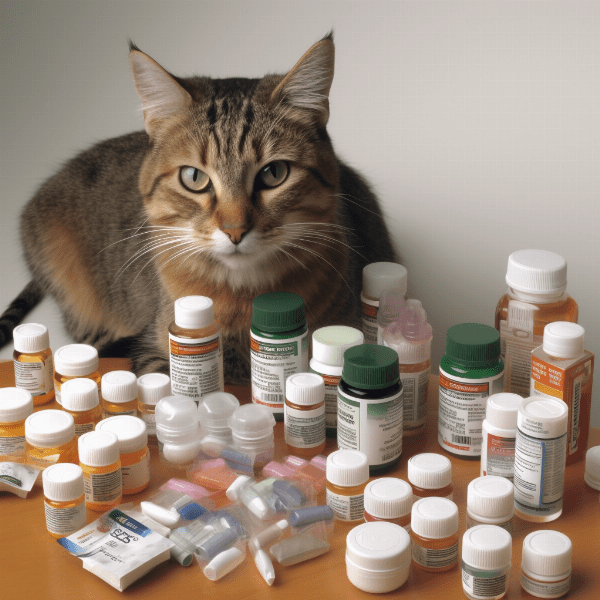
Surgical Options for Severe Cases
In severe cases of conjunctivitis, surgery may be necessary to treat the condition and prevent complications. Here are some of the surgical options for severe cases of feline conjunctivitis:
Eyelid Surgery
If your cat’s conjunctivitis is causing their eyelids to turn inward or outward (known as entropion or ectropion), surgery may be necessary to correct the eyelid position. This can help prevent further damage to the eye and reduce the risk of complications.
Corneal Transplant
In cases of severe corneal damage or scarring caused by conjunctivitis, a corneal transplant may be necessary to restore vision and prevent further damage to the eye. This involves removing the damaged cornea and replacing it with a healthy cornea from a donor.
Enucleation
In some cases, the damage caused by conjunctivitis may be so severe that it is necessary to remove the affected eye. This procedure, known as enucleation, involves surgically removing the eye and sealing the socket to prevent infection.
It’s important to note that these surgical options are usually reserved for severe cases of conjunctivitis that have not responded to other treatments. Your veterinarian will be able to recommend the best course of treatment for your cat’s specific condition, taking into account their overall health and the severity of their symptoms.

Follow-up Care for Cats with Conjunctivitis
After your cat has been treated for conjunctivitis, it’s important to follow up with your veterinarian to ensure that they are healing properly and to prevent the condition from recurring. Here are some tips for follow-up care for cats with conjunctivitis:
Administer Medications as Prescribed
It’s important to administer any medications prescribed by your veterinarian exactly as directed. This includes the dosage and frequency of administration, as well as the duration of treatment. If you have any questions or concerns about your cat’s medication, be sure to contact your veterinarian.
Monitor Symptoms
Keep a close eye on your cat’s symptoms to make sure they are improving. If you notice any new or worsening symptoms, or if your cat’s symptoms do not improve after several days of treatment, contact your veterinarian.
Schedule Follow-up Appointments
Your veterinarian may recommend follow-up appointments to monitor your cat’s progress and adjust their treatment plan as needed. Be sure to schedule these appointments and keep them as directed.
Prevent Reinfection
Take steps to prevent your cat from being reinfected with conjunctivitis. This includes practicing good hygiene, keeping their living area clean, and avoiding exposure to potential sources of infection.
Address Underlying Health Conditions
If your cat’s conjunctivitis was caused by an underlying health condition, such as a weakened immune system, it’s important to address this condition to prevent the conjunctivitis from recurring.
By following these tips and working closely with your veterinarian, you can help ensure that your cat’s conjunctivitis is properly treated and that they make a full recovery.

When to See a Veterinarian for Feline Conjunctivitis
If you suspect that your cat may have conjunctivitis, it’s important to seek veterinary care as soon as possible to prevent the condition from becoming more severe and to reduce the risk of complications. Here are some signs that indicate it’s time to see a veterinarian for feline conjunctivitis:
Redness and Swelling
If your cat’s eye appears red and swollen, it’s a sign that they may have conjunctivitis. Inflammation of the conjunctiva is a hallmark symptom of the condition.
Discharge
If your cat’s eye is producing discharge, such as pus or mucus, it’s a sign that they may have conjunctivitis. Discharge is a common symptom of the condition and can indicate an infection.
Cloudiness or Changes in Vision
If your cat’s eye appears cloudy or they are experiencing changes in their vision, it’s a sign that they may have severe conjunctivitis or a more serious eye condition. This requires immediate veterinary care.
Excessive Blinking or Squinting
If your cat is blinking or squinting excessively, it’s a sign that their eye is irritated or painful. Conjunctivitis can cause discomfort and pain in the eye, which can lead to excessive blinking or squinting.
Loss of Appetite or Lethargy
If your cat is experiencing a loss of appetite, lethargy, or other signs of illness in addition to conjunctivitis, it may indicate a more serious underlying health condition. Seek veterinary care as soon as possible.
If you notice any of these signs in your cat, it’s important to seek veterinary care as soon as possible. Early diagnosis and treatment can help prevent the condition from becoming more severe and reduce the risk of complications.


